Menus
- 27 years of Kawasaki sports tourers: GPZ 900 R and Z 1000 SX
- Conclusion
- Kawasaki GPZ 900 R.
- Kawasaki Z 1000 SX
- MOTORCYCLE measurements
- Model history
- Touring and Supersport
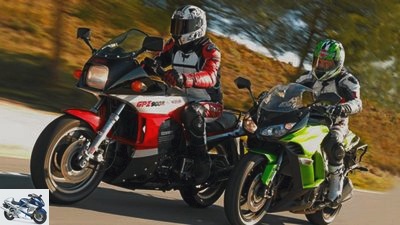
Bilski
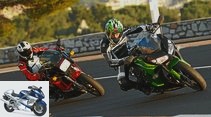
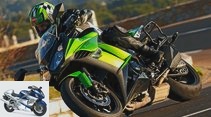
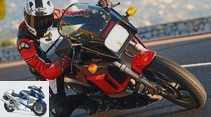
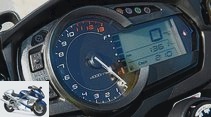
21st photos
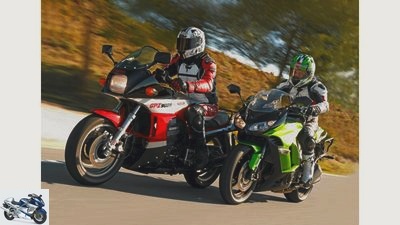
Bilski
1/21
In 1984 the Kawasaki GPZ 900 R was a big hit. It filled a gap between tourers and athletes. 27 years later, the Kawasaki Z 1000 SX follows and follows in the footsteps of GPZ. The comparison of the two generations shows how the older bike can keep up.
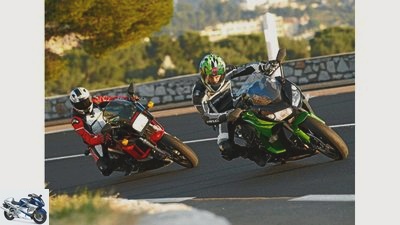
Bilski
2/21
You sit more comfortably on the new one, but the GPZ remains more neutral in an inclined position.
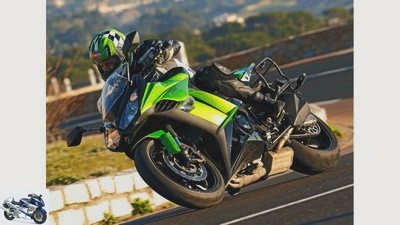
Bilski
3/21
Hurry up. One twist of the wrist and the Z 1000 dives forward.
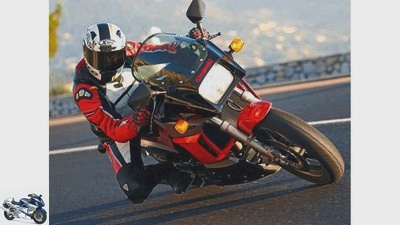
Bilski
4/21
Switch on. Has something to give the old Sport-Schlegel the spurs. You feel inspired.
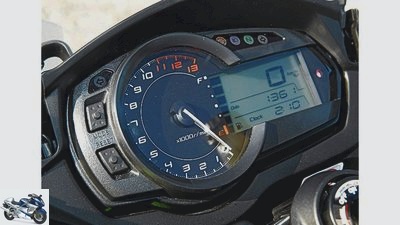
Bilski
5/21
Clearly structured: The Z 1000 SX has an easy-to-read classic tachometer with a digital speedometer and LCD fuel gauge.
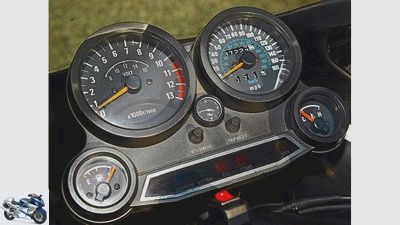
Bilski
6/21
Watch parade: large rev counter with integrated voltmeter, mileage tachometer, fuel gauge, cooling water thermometer of the GPZ 900 R.
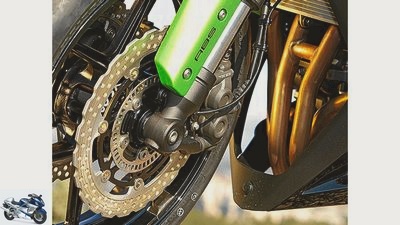
Bilski
7/21
Top of the Z 1000 SX: ABS, radial four-piston calipers, upside-down fork, stainless steel elbow with power-generating interference tubes.
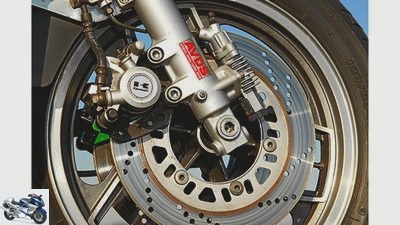
Bilski
8/21
Modern at the time: Today the 16-inch wheel, slack single-piston floating caliper brakes and anti-dive baroque look like the GPZ 900 R..
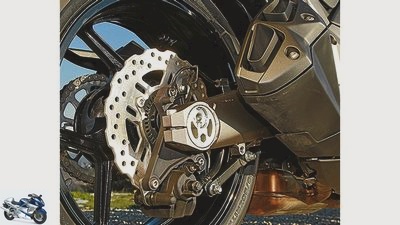
Bilski
9/21
Addition: The Z 1000 SX has a wave brake disc and a flap in the right of the two voluminous mufflers.
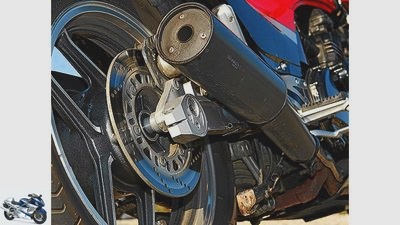
Bilski
10/21
State of the art: aluminum swingarms with beautiful and practical eccentrics have a long tradition at Kawasaki, as with the GPZ 900 R..
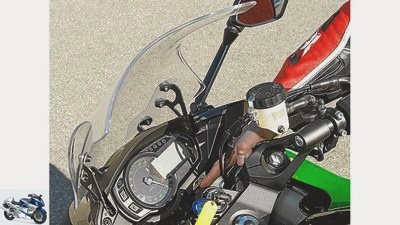
Bilski
11/21
Simple but effective: at the push of a button, the non-oversized pane of the Z 1000 SX can be locked in three stages in a flash.
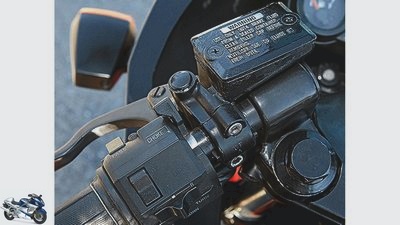
Bilski
12/21
Future-proof on the GPZ 900 R: Choke on the handlebar, hydraulically operated clutch and air-assisted fork (right handlebar).
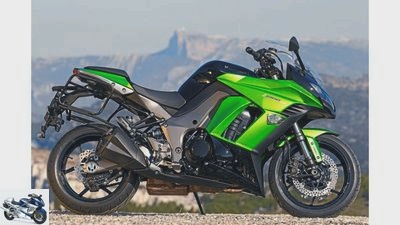
Bilski
13/21
Short, compact, stocky. Today the Z 1000 SX has a modern 1.44 meter wheelbase, 65.5 ° steering head angle and 79 centimeter wide, 1.02 meter high handlebar stubs.
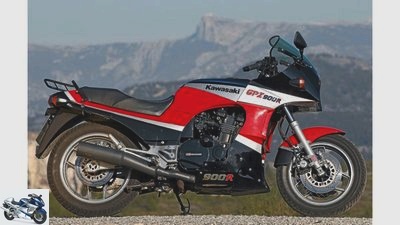
Bilski
14/21
Long, narrow, lean on the GPZ 900 R. Wheelbase 1495 millimeters, fork set flat at 61 °. And then the handlebars: 71 centimeters narrow and 95 centimeters low.
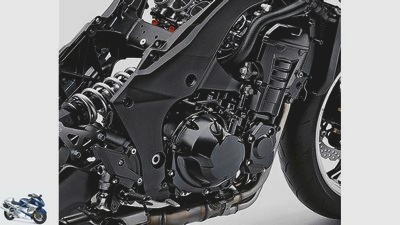
Bilski
15/21
Double throttle valves (outer four controlled by the on-board computer and designed oval), aluminum bridge frame, right-hand spring strut on the Z 1000 SX.
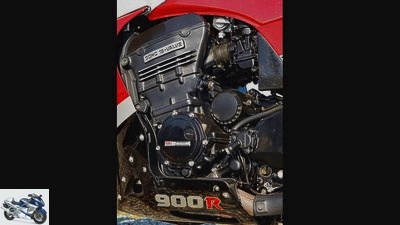
Bilski
16/21
Well thought-out for the GPZ 900 R: the alternator behind the cylinders makes it narrow, the left-hand camshaft drive saves a bearing. Standard: constant pressure carburetor and fuel tap.
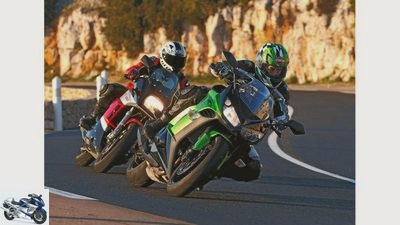
Bilski
17/21
The two winners meet: Kawasaki GPZ 90 R and Z 1000 SX.
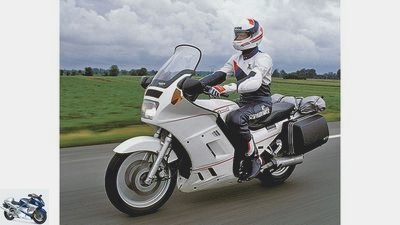
Bilski
18/21
The specialization of the Kawasakis after the GPZ 900 R is increasing: Here the Kawasaki 1000 GTR – cardan, case, full fairing, high handlebars and lush seats – that’s how people traveled from 1986.
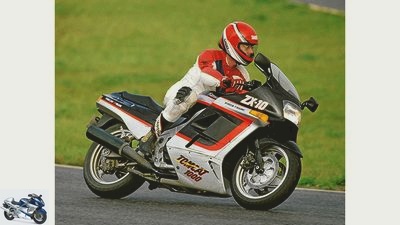
Bilski
19/21
Kawasaki ZX-10: With an aluminum frame, 137 hp and 17-inch front wheel, it heralded the new era of sports touring in 1988.
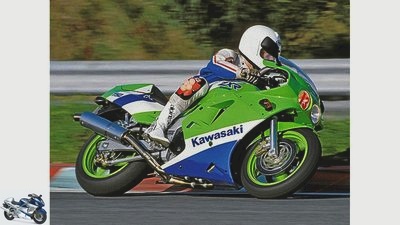
Bilski
20/21
Kawasaki ZXR 750: Kawasaki’s first super sports car in 1989 still had 750 cc and weighed around 230 kilograms.
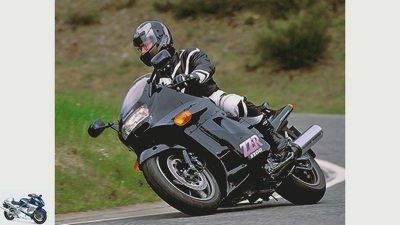
Bilski
21/21
Kawasaki ZZR 1100: 147 PS and Ram-Air-System, again in 1990 a Kawa was the fastest production bike.
Generation comparison
27 years of Kawasaki sports tourers: GPZ 900 R and Z 1000 SX
One was the superbike in 1984 and turned into a great touring athlete in the course of her remarkable career. The other is the most exciting, best sports tourer of 2011. How much soul is the GPZ 900 R in the new Z 1000 SX?
It was a crazy year, 1984. The cold war raged, the USSR stationed new nuclear missiles in the GDR, the unfortunate US President Ronald Reagan announced in a microphone test: "The bombing of Russia begins in five minutes". There was no internet yet, our computers were called Atari and Commodore C 64. And the Kawasaki GPZ 900 R was exactly ten years after the Z 900 "Frankenstein’s daughter", more, much more than just a new motorcycle.
Their angular, pointed half-shell cladding in the style of the older air-cooled sisters GPZ 1100 and 750 Turbo looked like the lower lip of Darth Vader in "war of stars". This is exactly what the 900s looked like, like a real messenger from the future. Equipped with everything that was possible in series production back then. Water cooling – for the first time in a Japanese inline four-cylinder -, additional oil cooler, 16 valves, six-speed gearbox, chain slot on the left side of the engine. In addition, open 115 hp from just 908 cubic centimeters. Kawasaki had changed the motorcycle world in one fell swoop, duping the larger-capacity competition.
Buy complete article
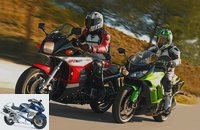
Generation comparison
27 years of Kawasaki sports tourers: GPZ 900 R and Z 1000 SX
Bilski
You sit more comfortably on the new one, but the GPZ remains more neutral in an inclined position.
Z and GPZ are worlds apart when you simply sit down. The 900er looks more delicate, longer, narrower. You have to stretch out over its long 22-liter tank to the narrow handlebars that feel like they are pulled down at a 45-degree angle. The seating position on the shorter, squat Z is completely different. In the 21st century you sit much closer to the wider, horizontal handlebars. Upright and yet much more front-wheel oriented. Fine. When switching directly, you feel as if you are directly above the steering head, although you are "just" squats seven centimeters forward. On the Z, the hood-shaped tank arches around the knees, so you sit much better integrated into the motorcycle. Knew how.
Every cold start is worth a thousand words. The new one is a child of the electronics age, push the button, done. Injection takes care of the rest. Okay, the idle speed stays quite high for a while. However, it is much more difficult to readjust the choke for the four 34 mm Keihin constant pressure carburettors from the GPZ. Either the engine revs too high or it spurts, does not take up the gas and goes out again. Even when the engine is warm, the GPZ driver should be able to master the interaction of clutch, throttle grip and shift foot on the somewhat bony gearbox. Because the 900 initially falls into a small performance gap. Is that the calm before the storm?
The GPZ only starts at 4000 tours, at 5500 rpm it becomes fiery. After that, the emotional kicks even more. Holla, there’s something going on. Only the view of the storm ahead of the 1000 meter demoralized. "I’m off", is their motto. Just like that, with every tiny twist of the throttle. There are few more powerful motorcycles. In sixth gear, it masters every intermediate sprint twice as fast as the GPZ. Exit sign, shower on and in 3.2 seconds you are from 60 to 100. Wow, how it pushes from bottom to top. The power in bags. When worn down, the GPZ panting behind in 6.3 seconds, is still an old-school sports engine – little below, everything above.
Even when turning out of gear, today’s sports tourer outclasses the sportsman of yore. 15 percent more cubic capacity and real 26 more horsepower meet 20 kilograms less combat weight: 258 kilograms stamp the wiry-looking GPZ to Moppelchen. The Z 1000 SX weighs 238 kilograms "Tourer", including carrier system for your standard 35-liter suitcase. All of this results in a different dimension of propulsion. Tears of emotion bring this pure power to your eyes. The muscle man pulls out all the stops. Double size 38 throttle valves are designed to optimize the flow conditions and thereby the filling and response behavior when accelerating.
Bilski
Hurry up. One twist of the wrist and the Z 1000 dives forward.
Obviously with success. Okay, the load change reactions of the Z are more armed, their engine jumps on the accelerator a little harder from the overrun mode than that of the GPZ. The carburettors can be accelerated much more smoothly. But the Z celebrates the power and magnificence of the four-cylinder, the engine that made Japan great, like no other. On the outlet side, interference pipes between stainless steel manifolds number one and four as well as two and three help in the search for beefy torque.
The same applies – in addition to noise measurement criteria – for the flap in the right of the two angular exhausts. Their four outlets make a four-in-four system difficult. The bread box-shaped front silencer is bulky. Lambda probe and regulated catalytic exhaust gas cleaning take much more consideration of the environment than the 900, which happily smells of fuel. The Zett growls with a dull whisper, sonorous and discreetly promising power. The GPZ sounds tinny, bellier, hoarse from the four-in-two. Its mechanical background noise is quite high. Klappersaki? However, the new engine vibrates more obtrusively, despite all the efforts of the balance shaft.
The word "feedback" hardly knew motorcycle chassis in 1984. The GPZ is a little heavy on its sluggishly appealing spring elements. And that although Uni-Trak rear suspension and air-assisted fork were all the rage back then. The whole chassis looks doughier, the butt hangs low for an athlete, and at high freeway speeds much more sentimental than the rigid Z. The GPZ fork rumbles insensitively over the humped surface and bounces poorly. Probably a consequence of the almost ineffective hydraulic anti-dive system. By increasing the damper pressure level, it should reduce the compression caused by the shift in the center of gravity when braking. Something like that ended up in the junkyard of history with good reason.
With the modern, front-heavy chassis, you always feel one-to-one what is coming under your wheels. The fully adjustable upside-down fork is sensitive, stable and comfortable. The easily accessible central spring strut, which is softer than that of the bare Z, combines comfort with high damping and suspension reserves.
Bilski
Switch on. Has something to give the old Sport-Schlegel the spurs. You feel inspired.
Almost the successful squaring of the circle: Today it is tighter, smoother and more comfortable! Zooms through the Z curves of any radius. Great. Its aluminum backbone frame is in a different league of stability than the steel counterpart of the 900 series. The Bridgestone BT 016 BB allow the SX to lean more easily than the bare Z. In corners you have to keep the 1000 on course with a little force on the reins. The wide 190/50 rear roller stands up on pimply asphalt and reacts sensitively to waves in an inclined position. This is especially true when using the powerful brake.
In tight, brisk corners, the Z drifts outwards in case of doubt, the GPZ tends to fall even further inwards. No wonder, with a chopper-like flat steering head and a small 16-inch model at the front. In general, the GPZ remains more relaxed in an inclined position and falls even more easily into it despite the long wheelbase and narrow handlebars. A feat, its 130/80 rear tire is hardly wider than the front of the Z 1000. Surprise: At temperatures around freezing point, the best of all bias tires, Bridgestone BT 45, the GPZ are better than the radial tires from sister Z. However, the 900 is better cut off from all other modern tire constructions with 18 inches at the rear and 16 inches at the front. Makes only 17 inches on average…
In the case of the brakes, the two Kawas originate from separate galaxies. When things get really tight, when a driver thinks they still have to pull out, one can get scared on the youngtimer. You pull and pull the lever and it happens – nothing. With the single-piston floating calipers, a lot of hand strength meets poor deceleration. In contrast, the radially screwed four-piston calipers of the Z look like someone has stuck a stick into the spokes – but they are much easier to dose. The safety feeling provided by the standard ABS is priceless on damp spots.
This is progress that is really liberating. In 1984 the GPZ cost 11,790 marks, 6,028 euros. A normal wage earner had to work purely arithmetically for four months; he received 17,530 euros gross in the year. A Z 1000 SX Tourer costs more than twice as much as the GPZ back then, 13,295 euros. Quite a bit, for that you have to plow for five months with an average wage of 30,880 euros. But the technical progress is enormous. The Z is "added value". In terms of strength, it is in a league of its own, and like the 900s, it has plenty of character.
What about karma? Well, as an irony of fate, the GPZ 900 R has become a cult bike, unlike many of its designated successors, a rolling legend. Maybe it is time to put such a timeless classic in the garage. Or do you invest six to seven times as much for a current, brand-new Z 1000 SX? It’s the better, much better motorcycle in almost every respect.
Conclusion
Bilski
The two winners meet: Kawasaki GPZ 90 R and Z 1000 SX.
This is where two Kawasaki winners meet. Both have won series of comparative tests. The GPZ is cult and still inspires today with its charm and versatility. Accelerate, bounce, dampen, brake – objectively, the modern Z 1000 SX can do practically everything better. Worlds lie between the measured values from 1984 and 2011. Even more than active youngtimer drivers would assume. Especially since the new 1000 is a damn big hit. We will remember them fondly, too, in 2038.
Kawasaki GPZ 900 R.
Bilski
Long, narrow, lean on the GPZ 900 R. Wheelbase 1495 millimeters, fork set flat at 61 °. And then the handlebars: 71 centimeters narrow and 95 centimeters low.
engine:
Water-cooled four-cylinder four-stroke in-line engine, two overhead, chain-driven camshafts, four valves per cylinder, rocker arms, wet sump lubrication, constant pressure carburetor, Ø 34 mm, hydraulically operated multi-disc oil bath clutch, six-speed gearbox, O-ring chain.
Bore x stroke 72.50 x 55.0 mm
Displacement 908 cc
Compression ratio 11: 1
rated capacity 84 kW (115 PS) at 9500 rpm
Max. Torque 86 Nm at 8500 rpm
Landing gear:
Backbone frame made of steel, load-bearing motor, telescopic fork, Ø 38 mm, two-arm swing arm made of aluminum, central spring strut with lever system, adjustable spring base, double disc brake at the front, Ø 280 mm, single-piston floating caliper, rear disc brake, Ø 250 mm, single-piston floating caliper.
Cast aluminum wheels 2.50 x 16; 3.00 x 18
Tires 120/80 V 16; 130/80 V 18
Bridgestone BT 45 tires tested
Mass and weight:
Wheelbase 1495 mm, steering head angle 61.0 degrees, caster 114 mm, spring travel f / r 140/115 mm, seat height * 790 mm, weight with a full tank * 258 kg, payload * 172 kg, tank capacity 22.0 liters.
Prize 1984: 11790 marks (6028 euros)
Kawasaki Z 1000 SX
Bilski
Short, compact, stocky. Today the Z 1000 SX has a modern 1.44 meter wheelbase, 65.5 ° steering head angle and 79 centimeter wide, 1.02 meter high handlebar stubs.
engine:
Water-cooled four-cylinder four-stroke in-line engine, a balance shaft, two overhead, chain-driven camshafts, four valves per cylinder, bucket tappets, wet sump lubrication, injection, Ø 38 mm, G-Kat, mech. actuated multi-disc oil bath clutch, six-speed gearbox, O-ring chain.
Bore x stroke 77.0 x 56.0 mm
Displacement 1043 cc
Compression ratio 11.8: 1
rated capacity 101.5 kW (138 hp) at 9600 rpm
Max. Torque 110 Nm at 7800 rpm
landing gear:
Backbone frame made of aluminum, load-bearing motor, upside-down fork, Ø 41 mm, adjustable spring base, rebound and compression damping, two-arm swing arm made of aluminum, central spring strut with lever system, adjustable spring base and rebound damping, double disc brake at the front, Ø 300 mm, four-piston fixed calipers, disc brake rear, Ø 250 mm, single-piston floating caliper, ABS.
Cast aluminum wheels 3.50 x 17; 6.00 x 17
Tires 120/70 ZR 17; 190/50 ZR 17
Bridgestone BT 016 BB tires tested
Mass and weight:
Wheelbase 1440 mm, steering head angle 65.5 degrees, caster 102 mm, spring travel f / r 120/138 mm, seat height * 820 mm, weight with a full tank * 238 kg, payload * 187 kg, tank capacity 19.0 liters.
Price: 13 295 euros plus NK (tourer version)
MOTORCYCLE measurements
Drawing: archive
The performance diagram of the two bikes.
At any speed, the full 1043 cm3 engine delivers between ten and 30 hp more than its ancestor with 908 cm3. At 3500 tours, the Z 1000 already delivers as much torque (85 Newton meters) as the maximum GPZ can achieve at a high 8400 rpm. In addition, the performance curve of the 900 is more wavy, it only really starts from 5500 rpm after a slight starting weakness. No wonder that the Z 1000 mercilessly pulls off the athlete of yore: In sixth gear, it is as fast from 60 to 140 as the GPZ from 60 to 100!
Top speed (Manufacturer information):
| Manufacturer | Km / h | GPZ 900 R | 241 |
| Z 1000 SX | 245 |
Acceleration:
| Manufacturer | 0-100 km / h | 0-140 km / h | 0-200 km / h (sec) | GPZ 900 R | 3.9 | 6.5 | 15.3 |
| Z 1000 SX | 3.3 | 5.0 | 9.6 |
Draft:
| Manufacturer | 60-100 km / h |
100-140 km / h |
140-180 km / h (sec) |
| GPZ 900 R | 6.3 | 6.4 | 7.53 | Z 1000 SX | 3.3 | 3.2 | 3.5 |
Model history
Bilski
The specialization of the Kawasakis after the GPZ 900 R is increasing: Here the Kawasaki 1000 GTR – cardan, case, full fairing, high handlebars and lush seats – that’s how people traveled from 1986.
An athlete of yore was still "one machine for everything". But since the mid-1980s, specialization in extremes has continued to increase.
The GPZ 900 R was a really big hit in 1984: extremely fast, super powerful, beautiful. However, it was not a sports machine or a racing motorcycle. It fell through the grid of all racing classes right from the start and, at 258 kilograms, was too heavy for circuits. A 500cc GP machine weighed only half that. Nevertheless, the versatile GPZ successfully filled a gap in time, between the past and the modern age. With it you could even go on holiday for two, burn over the track or heat over the Nordschleife. But in 1985 the GSX-750 appeared as the first real super sports car, something that was still called 25 years ago "Hypersports". From now on, sports bikes became much lighter and faster. But they have lost some of their all-round properties. The irony of the recurring story is that the famous sportsman GPZ 900 R has now matured into a sports tourer (back then it was called touring sportsman). And how. It was on sale in Germany until 1993, and it rolled off the production line in Japan for ten years longer (!). And it has been sold more than 60,000 times worldwide, 9,100 of them in Germany. A great career. Nevertheless, Kawasaki worked early on potential successors with four-cylinder engines that were becoming more and more extreme.
Touring and Supersport
Bilski
Kawasaki ZX-10: With an aluminum frame, 137 hp and 17-inch front wheel, it heralded the new era of sports touring in 1988.
The GPZ 1000 RX kicked off in 1986 with more bore and stroke than the 900: Open 125 hp, at that time 100 hp self-restraint was still in force in Germany, and then almost 250 km / h. She also donated the four-cylinder for the Supertourer 1000 GTR, tamed there by other camshafts and smaller carburettors. The GTR central tube frame was derived from the 900 GPZ.
Fern, Schnell, gut, the first ZX-10, Kawasaki’s new 137-hp flagship in 1988, paid homage to the balancing act of sport touring ideals. A completely new series, the ZZ-R 600 and 1100, has united such a wide range of applications since 1990. The 147 hp 1100er Express was the first motorcycle to have a ram-air air inlet to improve the filling at high speed. Its performance, comfort and weight (270 kilograms) were immense. In contrast, the ZXR 750 was Kawasaki’s 1989 answer to the uncompromising world of GSX-R, CBR and FZR. "Vacuum cleaner hoses" Over the tank and endurance-like double headlights made them legendary. Today, a ZX-10R is the legitimate ancestor of 200 hp with a fighting weight of only 200 kilograms. A fast racing replica for the road, with enormous charisma, but without any great everyday use or passenger comfort. The big bike sport tourers are breaking into this gap.
Related articles
-
Comparison test of the 1000 super sports car, part 1
Jahn comparison test 1000 super sports car, part 1 The full range Slim, strong, ready to attack, with the Suzuki GSX-R 1000 is the field of …
-
Comparison test sports tourer Kawasaki Z 1000 SX Tourer, Triumph Sprint GT
www. 35 pictures www. 1/35 Sports tourers sit between all chairs, but the temptation lies in this niche: there are bikes, …
-
Kawasaki Z 1000 – model years 2004 and 2014 in a comparison test
fact 16 pictures fact 1/16 memories of the old Z 900 and Z 1000 times were made possible by the “four-in-two-in-four exhaust system” with its four …
-
Comparison test of mid-range tourers
Comparison test of the middle class tourer Green Week Curves over curves in the midst of oxygen-rich forests and lush green meadows. The Thuringian Forest offers …
-
Comparison test: Kawasaki ER-6n against Versys
Bilski 17 pictures Bilski 1/17 Both the Kawasaki ER-6n and Versys achieved huge sales success. But which of the two can directly …
-
Comparison test: Kawasaki KLX 250 against Yamaha WR 250 R
Comparative test: 250cc Enduro Kawasaki KLX 250 versus Yamaha WR 250 R Not everyone who likes to ride Enduro wants to get through the undergrowth in the fastest time …
-
Concept comparison sports tourer
Art 12 pictures BMW 1/12 driving fun in BMW style. BMW 2/12 eye-catcher: the cladding in lava orange metallic. BMW 3/12 With an engine power of …
-
Comparison test: super sports cars under 1000 cubic meters from MV Agusta, Ducati and Kawasaki
Jahn 46 pictures Jahn 1/46 Kawasaki ZX-6R 636 Jahn 2/46 But the Evo is not alone in this. All three bikes rock the ring during the test. Jahn 3/46 ……
-
BMW, Honda, Kawasaki, Suzuki and Yamaha super sports cars in a comparison test
Judd 26 pictures Nicolaou 1/26 In the super sports car comparison test: Kawasaki ZX-10R, BMW S 1000 RR, Suzuki GSX-R 1000, Honda Fireblade C-ABS and Yamaha YZF-R1 ….
-
Comparison test BMW K 1300 S, Kawasaki ZZR 1400, Suzuki Hayabusa 1300
Gargolov comparison test BMW K 1300 S, Kawasaki ZZR 1400, Suzuki Hayabusa 1300 Speedbikes in comparison The wind tunnel shaped their faces, their beefy …